Immigration is a life-changing journey, and for many, navigating the complex legal landscape requires the expertise of a skilled immigration consultant. Your website is often the first point of contact for potential clients, acting as your digital storefront and a crucial tool for building trust and attracting new business. An effective immigration consultant website isn’t just a pretty face; it’s a strategically designed platform that informs, engages, and converts visitors into paying clients. Let’s dive into the essential features that will transform your website into a powerhouse for your immigration consulting practice.
Quick Summary:
- Create a compelling, trustworthy homepage.
- Provide detailed services and easy communication options.
- Ensure site is secure, mobile, searchable, and always updated.
Table of Contents
- 1. Compelling and Informative Homepage: First Impressions Matter
- 1.1. Crystal-Clear Value Proposition: Answering “What’s In It For Me?”
- 1.2. Engaging Visuals: Showing, Not Just Telling
- 1.3. Clear Call-to-Actions (CTAs): Guiding the User Journey
- 1.4. Trust Signals: Building Credibility
- 2. Detailed Service Pages: Showcasing Expertise and Value
- 2.1. Comprehensive Visa and Immigration Information: Becoming the Go-To Resource
- 2.2. Service Packages: Offering Customized Solutions
- 2.3. Case Studies: Demonstrating Success and Building Confidence
- 2.4. FAQ Section: Addressing Common Questions and Concerns
- 3. Resource Center: Providing Value Beyond Services
- 3.1. Blog: Sharing Expertise and Attracting Organic Traffic
- 3.2. Guides and Checklists: Offering Practical Assistance
- 3.3. News and Updates: Keeping Clients Informed
- 3.4. Glossary of Immigration Terms: Demystifying Legal Jargon
- 4. User-Friendly Navigation and Design: Ensuring a Seamless Experience
- 4.1. Intuitive Navigation: Guiding Visitors Effortlessly
- 4.2. Mobile-Responsive Design: Reaching Users on Any Device
- 4.3. Accessibility: Catering to All Users
- 4.4. Fast Loading Speed: Keeping Visitors Engaged
- 5. Robust Contact and Communication Features: Facilitating Engagement
- 5.1. Contact Forms: Streamlining Inquiries
- 5.2. Live Chat: Providing Instant Support
- 5.3. Phone Number and Email Address: Providing Direct Access
- 5.4. Social Media Integration: Expanding Reach and Engagement
- 6. Security and Privacy: Protecting Client Information
- 6.1. SSL Certificate: Ensuring Data Encryption
- 6.2. Privacy Policy: Transparency and Compliance
- 6.3. Secure Payment Processing: Protecting Financial Data
- 7. Search Engine Optimization (SEO): Driving Organic Traffic
- 7.1. Keyword Research: Identifying Relevant Search Terms
- 7.2. On-Page Optimization: Optimizing Website Content
- 7.3. Off-Page Optimization: Building Authority and Backlinks
- 7.4. Local SEO: Targeting Local Clients
- 8. Analytics and Tracking: Measuring Performance and Making Improvements
- 8.1. Google Analytics: Tracking Website Traffic and User Behavior
- 8.2. Conversion Tracking: Measuring the Effectiveness of Marketing Campaigns
- 8.3. A/B Testing: Optimizing Website Elements for Conversion
- 9. Multilingual Support: Reaching a Global Audience
- 9.1. Professional Translation: Ensuring Accuracy and Cultural Sensitivity
- 9.2. Language Switcher: Making it Easy for Users to Select Their Preferred Language
- 9.3. Localized Content: Tailoring Content to Specific Regions
- 10. Ongoing Maintenance and Updates: Keeping Your Website Fresh and Relevant
- 10.1. Regular Content Updates: Adding New Content and Keeping Information Current
- 10.2. Security Updates: Protecting Your Website from Cyber Threats
- 10.3. Performance Monitoring: Ensuring Optimal Website Speed and Functionality
- 11. Qrolic Technologies: Your Partner in Immigration Website Development
- 11.1. Our Services: Tailored Solutions for Immigration Consultants
- 11.2. Why Choose Qrolic Technologies?
- 11.3. Get Started Today: Transforming Your Online Presence
1. Compelling and Informative Homepage: First Impressions Matter
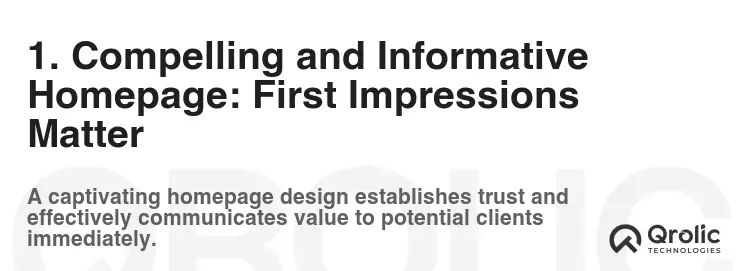
Your homepage is your virtual handshake. It needs to immediately grab the visitor’s attention and clearly communicate what you do and why they should choose you.
1.1. Crystal-Clear Value Proposition: Answering “What’s In It For Me?”
- Headline Power: Your headline should immediately convey the core benefit of your services. Instead of generic statements like “Immigration Consulting Services,” try something like “Unlock Your Dream: Expert Guidance Through the Canadian Immigration Process.”
- Subheading Support: Reinforce your headline with a concise subheading that further clarifies your specialization or target audience. For example, “Helping Skilled Workers, Families, and Students Achieve Their Immigration Goals.”
- Benefit-Driven Language: Focus on the outcomes you provide, not just the services. Instead of “We handle visa applications,” say “We help you obtain the visa you need to start your new life.”
- Keywords: Intelligently place keywords such as “immigration website”, “immigration consultants” and location based keywords if you target local customers.
1.2. Engaging Visuals: Showing, Not Just Telling
- High-Quality Images: Use professional-grade photos that depict diversity, success, and the welcoming spirit of your target country. Avoid generic stock photos that look staged.
- Video Introduction: A short, personal video message from the principal consultant can significantly boost trust and connection. Discuss your passion for immigration and your commitment to client success.
- Infographics: Use infographics to visually represent complex immigration processes, statistics, or success stories.
- Interactive elements: Include interactive elements, for example a world map where a user clicks the country they are interested in, and they’re taken to that specific immigration page.
1.3. Clear Call-to-Actions (CTAs): Guiding the User Journey
- Strategic Placement: CTAs should be prominent and strategically placed throughout the homepage, guiding visitors towards the next step.
- Action-Oriented Language: Use strong verbs like “Get Started,” “Apply Now,” “Schedule a Consultation,” or “Download Our Free Guide.”
- Visual Prominence: Use contrasting colors and button designs to make CTAs stand out.
- Personalization: Customize CTAs based on user behavior. For example, if a visitor has been browsing a specific visa type, offer a CTA related to that visa.
1.4. Trust Signals: Building Credibility
- Testimonials and Reviews: Prominently display testimonials from satisfied clients. Include photos and full names for added authenticity.
- Accreditations and Certifications: Showcase any relevant accreditations, certifications, or memberships from recognized immigration authorities.
- Awards and Recognition: Highlight any awards or recognition your firm has received.
- Security Badges: Display security badges to reassure visitors that their personal information is protected.
- “About Us” Snippet: Include a brief, compelling summary of your firm’s history, mission, and values.
2. Detailed Service Pages: Showcasing Expertise and Value
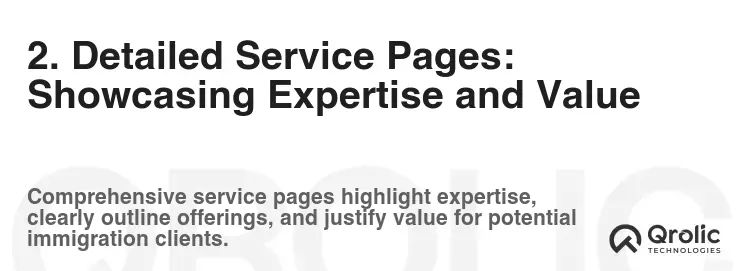
Each service you offer should have its own dedicated page, providing in-depth information and demonstrating your expertise. This is where you explain your “service packages” and the specific benefits clients receive.
2.1. Comprehensive Visa and Immigration Information: Becoming the Go-To Resource
- Targeted Content: Tailor the content to the specific visa type or immigration program.
- Eligibility Requirements: Clearly outline the eligibility criteria, including education, work experience, language proficiency, and financial requirements.
- Application Process: Provide a step-by-step guide to the application process, including required documents and timelines.
- Common Mistakes to Avoid: Help visitors avoid common pitfalls and delays by highlighting common mistakes applicants make.
- Country-Specific Information: if your company assists with multiple countries immigration then you should consider a dedicated page for each country
- Keywords: Use niche keywords related to each service to improve search engine visibility. For example, “Canadian Express Entry Program,” “US Family-Based Immigration,” or “Australian Skilled Migration Visa.”
2.2. Service Packages: Offering Customized Solutions
- Clearly Defined Packages: Offer different service packages tailored to different needs and budgets. For example:
- Basic Package: Document review and application assistance.
- Standard Package: Full application preparation and submission.
- Premium Package: Includes personalized consultation, interview preparation, and ongoing support.
- Transparent Pricing: Clearly state the fees associated with each package, avoiding hidden costs or surprises.
- Value Justification: Explain the value of each package, highlighting the benefits clients receive for their investment.
- Customization Options: Allow clients to customize packages to meet their specific needs.
- Comparison Charts: Use comparison charts to clearly differentiate the features and benefits of each package.
2.3. Case Studies: Demonstrating Success and Building Confidence
- Real-Life Examples: Showcase real-life examples of successful cases, demonstrating your expertise and track record.
- Detailed Narratives: Provide detailed narratives of each case study, including the client’s background, the challenges they faced, and the solutions you provided.
- Quantifiable Results: Highlight quantifiable results, such as visa approval rates, processing times, or client satisfaction scores.
- Client Testimonials: Include testimonials from the clients featured in the case studies.
- Diverse Representation: Showcase a diverse range of case studies representing different visa types, immigration programs, and client backgrounds.
- Anonymization: Ensure client privacy by anonymizing sensitive information if necessary.
- Keywords: Incorporate relevant keywords into case study descriptions to improve search engine visibility. For example, “Successful Canadian Spousal Sponsorship Case Study” or “Approved US Investor Visa Application.”
- Visual Appeal: Use high-quality images and videos to make case studies more engaging and visually appealing.
2.4. FAQ Section: Addressing Common Questions and Concerns
- Comprehensive Coverage: Address a wide range of frequently asked questions related to the immigration process, eligibility requirements, fees, and timelines.
- Clear and Concise Answers: Provide clear and concise answers that are easy to understand for non-legal professionals.
- Organized Structure: Organize FAQs by topic to make it easy for visitors to find the information they need.
- Search Functionality: Implement a search function to allow visitors to quickly search for specific questions.
- Regular Updates: Keep the FAQ section up-to-date with the latest immigration regulations and policies.
- Keywords: Optimize FAQs for search engines by incorporating relevant keywords into questions and answers.
3. Resource Center: Providing Value Beyond Services
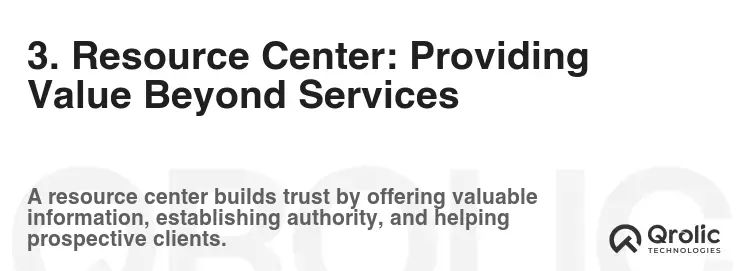
Establishing yourself as a trusted authority in the immigration field requires offering more than just your services. A well-stocked resource center provides valuable information and tools that attract and engage potential clients.
3.1. Blog: Sharing Expertise and Attracting Organic Traffic
- Informative Content: Create informative blog posts on relevant topics, such as changes in immigration law, tips for preparing visa applications, or profiles of successful immigrants.
- Keyword Research: Conduct keyword research to identify popular search terms related to immigration and use those keywords in your blog posts.
- Regular Updates: Publish new blog posts regularly to keep your content fresh and engaging.
- Guest Blogging: Invite guest bloggers to contribute content to your blog, expanding your reach and expertise.
- Interactive elements: Integrate interactive elements within the blog, such as quizzes to test user knowledge about immigration laws.
3.2. Guides and Checklists: Offering Practical Assistance
- Downloadable Resources: Offer downloadable guides and checklists that provide practical assistance with the immigration process.
- Lead Generation: Use these resources as lead magnets to capture contact information from potential clients.
- Valuable Content: Ensure that your guides and checklists are well-researched, informative, and easy to use.
- Mobile-Friendly Format: Optimize your guides and checklists for mobile devices.
3.3. News and Updates: Keeping Clients Informed
- Real-Time Information: Provide real-time news and updates on changes in immigration laws and policies.
- Reliable Sources: Cite reliable sources for your news and updates.
- Email Newsletter: Offer an email newsletter to keep subscribers informed of the latest news and updates.
- Social Media Sharing: Share your news and updates on social media platforms.
3.4. Glossary of Immigration Terms: Demystifying Legal Jargon
- Comprehensive Definitions: Provide comprehensive definitions of common immigration terms and acronyms.
- Easy-to-Understand Language: Use easy-to-understand language to explain complex legal concepts.
- Searchable Database: Create a searchable database of immigration terms.
4. User-Friendly Navigation and Design: Ensuring a Seamless Experience
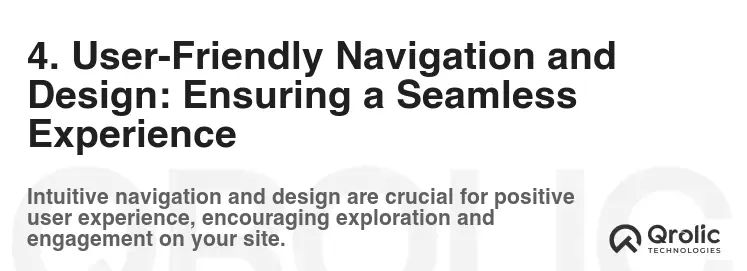
A beautiful website is useless if it’s difficult to navigate. User experience (UX) is paramount to keeping visitors engaged and converting them into clients.
4.1. Intuitive Navigation: Guiding Visitors Effortlessly
- Clear Menu Structure: Use a clear and concise menu structure that makes it easy for visitors to find the information they need.
- Dropdown Menus: Use dropdown menus to organize subcategories of information.
- Search Functionality: Implement a search function to allow visitors to quickly find specific information.
- Breadcrumb Navigation: Use breadcrumb navigation to help visitors understand their current location on the website.
4.2. Mobile-Responsive Design: Reaching Users on Any Device
- Mobile-First Approach: Design your website with a mobile-first approach to ensure that it looks and functions well on all devices.
- Responsive Layout: Use a responsive layout that automatically adjusts to the screen size of the device.
- Touch-Friendly Design: Design your website with touch-friendly elements that are easy to use on mobile devices.
- Fast Loading Times: Optimize your website for fast loading times on mobile devices.
4.3. Accessibility: Catering to All Users
- WCAG Compliance: Adhere to the Web Content Accessibility Guidelines (WCAG) to ensure that your website is accessible to people with disabilities.
- Alternative Text: Provide alternative text for all images to make them accessible to visually impaired users.
- Keyboard Navigation: Ensure that your website can be navigated using a keyboard.
- Color Contrast: Use sufficient color contrast to make your website readable for people with visual impairments.
4.4. Fast Loading Speed: Keeping Visitors Engaged
- Image Optimization: Optimize images for web use to reduce file sizes.
- Code Minification: Minify HTML, CSS, and JavaScript code to reduce file sizes.
- Caching: Implement caching to store frequently accessed data.
- Content Delivery Network (CDN): Use a CDN to distribute your website’s content across multiple servers.
5. Robust Contact and Communication Features: Facilitating Engagement
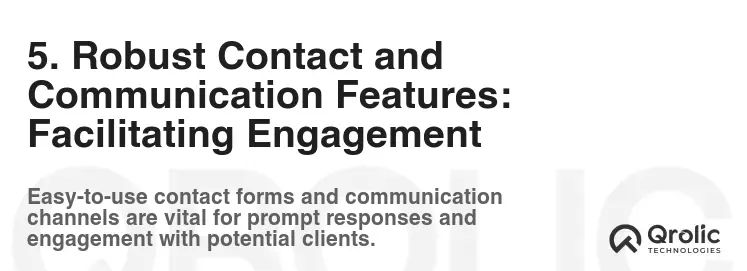
Making it easy for potential clients to reach you is crucial.
5.1. Contact Forms: Streamlining Inquiries
- Easy-to-Find Contact Page: Prominently display a link to your contact page in the website header and footer.
- Clear and Concise Form: Use a clear and concise contact form that collects the necessary information from potential clients.
- Captcha Protection: Implement captcha protection to prevent spam submissions.
- Confirmation Message: Display a confirmation message after a visitor submits the form.
- Automated Response: Send an automated email response to acknowledge receipt of the form and provide an estimated response time.
5.2. Live Chat: Providing Instant Support
- Real-Time Assistance: Offer live chat support to provide real-time assistance to visitors.
- Proactive Chat: Use proactive chat to engage visitors who are browsing specific pages.
- 24/7 Availability: Provide 24/7 live chat support, or clearly indicate your business hours.
- Trained Agents: Ensure that your live chat agents are well-trained and knowledgeable about immigration law.
5.3. Phone Number and Email Address: Providing Direct Access
- Prominent Display: Prominently display your phone number and email address in the website header and footer.
- Click-to-Call Functionality: Implement click-to-call functionality for mobile users.
- Professional Email Address: Use a professional email address associated with your domain name.
5.4. Social Media Integration: Expanding Reach and Engagement
- Social Media Icons: Display social media icons that link to your firm’s social media profiles.
- Social Sharing Buttons: Add social sharing buttons to your blog posts and service pages.
- Social Media Feed: Embed a social media feed on your website to display your latest social media posts.
6. Security and Privacy: Protecting Client Information

Immigration involves handling sensitive personal information. Security and privacy are non-negotiable.
6.1. SSL Certificate: Ensuring Data Encryption
- HTTPS Protocol: Install an SSL certificate to encrypt data transmitted between your website and visitors.
- Security Badges: Display security badges to reassure visitors that their information is protected.
6.2. Privacy Policy: Transparency and Compliance
- Clear and Concise Policy: Provide a clear and concise privacy policy that explains how you collect, use, and protect client information.
- GDPR Compliance: Comply with the General Data Protection Regulation (GDPR) if you collect data from European Union citizens.
- CCPA Compliance: Comply with the California Consumer Privacy Act (CCPA) if you collect data from California residents.
6.3. Secure Payment Processing: Protecting Financial Data
- PCI Compliance: Use a PCI-compliant payment gateway to process online payments securely.
- Encryption: Encrypt sensitive financial data to protect it from unauthorized access.
7. Search Engine Optimization (SEO): Driving Organic Traffic
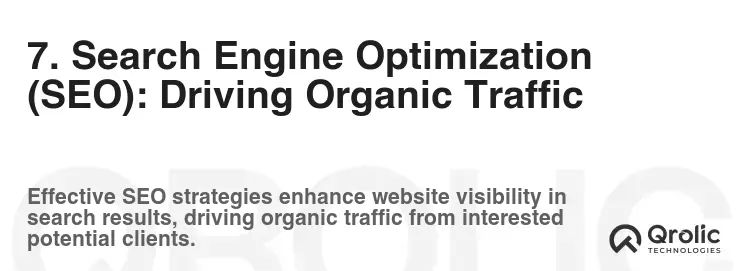
A beautiful and functional website is useless if no one can find it. SEO is essential for attracting organic traffic from search engines.
7.1. Keyword Research: Identifying Relevant Search Terms
- Target Keywords: Identify the keywords that potential clients are using to search for immigration consultants.
- Long-Tail Keywords: Target long-tail keywords that are more specific and less competitive.
- Keyword Tools: Use keyword research tools to identify relevant keywords and their search volume.
7.2. On-Page Optimization: Optimizing Website Content
- Title Tags: Optimize title tags with relevant keywords.
- Meta Descriptions: Write compelling meta descriptions that encourage users to click on your website in search results.
- Header Tags: Use header tags (H1, H2, H3, etc.) to structure your content and incorporate relevant keywords.
- Image Alt Text: Provide alternative text for all images to make them accessible to search engines.
- Internal Linking: Use internal links to connect related pages on your website.
- Mobile-Friendliness: Make sure your website is mobile-friendly.
- Page Speed: Improve your website’s page speed.
- Content Quality: Make sure you provide high-quality content.
7.3. Off-Page Optimization: Building Authority and Backlinks
- Link Building: Build high-quality backlinks from reputable websites in the immigration industry.
- Directory Submissions: Submit your website to relevant online directories.
- Social Media Marketing: Promote your website and content on social media platforms.
- Guest Blogging: Contribute guest posts to other websites in your industry.
7.4. Local SEO: Targeting Local Clients
- Google My Business: Claim and optimize your Google My Business listing.
- Local Citations: Build local citations on relevant websites.
- Local Keywords: Target local keywords in your website content.
8. Analytics and Tracking: Measuring Performance and Making Improvements
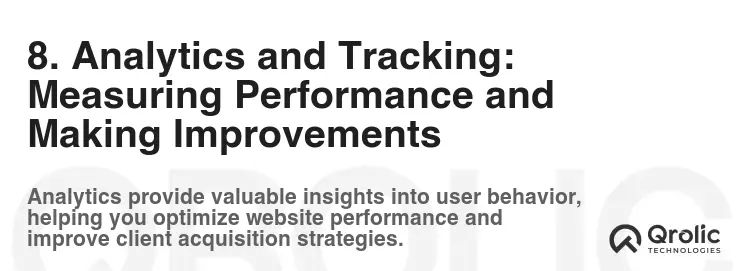
You can’t improve what you don’t measure. Analytics and tracking are essential for understanding website performance and making data-driven decisions.
8.1. Google Analytics: Tracking Website Traffic and User Behavior
- Set Up Google Analytics: Set up Google Analytics to track website traffic, user behavior, and conversions.
- Track Key Metrics: Track key metrics such as page views, bounce rate, time on site, and conversion rate.
- Analyze Data: Analyze the data to identify areas for improvement.
8.2. Conversion Tracking: Measuring the Effectiveness of Marketing Campaigns
- Set Up Conversion Tracking: Set up conversion tracking to measure the effectiveness of your marketing campaigns.
- Track Goals: Track goals such as form submissions, phone calls, and online purchases.
- Calculate ROI: Calculate the return on investment (ROI) of your marketing campaigns.
8.3. A/B Testing: Optimizing Website Elements for Conversion
- Identify Areas for Improvement: Identify areas on your website that could be optimized for conversion.
- Create Variations: Create variations of website elements such as headlines, images, and calls to action.
- Test Variations: Test the variations to see which one performs best.
- Implement Changes: Implement the changes that improve conversion rates.
9. Multilingual Support: Reaching a Global Audience
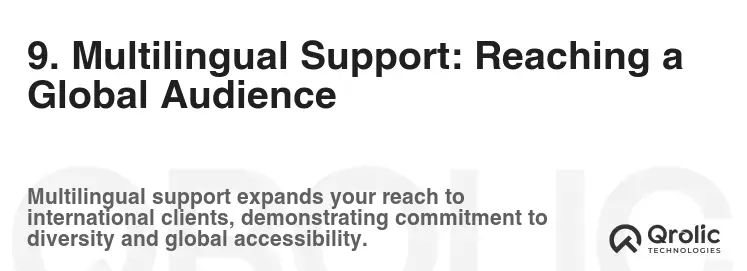
Immigration is inherently international. If you serve clients from multiple countries, multilingual support is essential.
9.1. Professional Translation: Ensuring Accuracy and Cultural Sensitivity
- Hire Professional Translators: Hire professional translators who are native speakers of the target languages.
- Avoid Machine Translation: Avoid using machine translation, as it can be inaccurate and culturally insensitive.
- Proofread Carefully: Proofread all translated content carefully to ensure accuracy.
9.2. Language Switcher: Making it Easy for Users to Select Their Preferred Language
- Prominent Placement: Place the language switcher in a prominent location on your website.
- Clear Labels: Use clear labels to identify the different languages available.
- Flag Icons: Use flag icons to visually represent the different languages.
9.3. Localized Content: Tailoring Content to Specific Regions
- Currency Conversion: Display prices in local currencies.
- Address Formats: Use local address formats.
- Cultural References: Use cultural references that are relevant to the target audience.
10. Ongoing Maintenance and Updates: Keeping Your Website Fresh and Relevant
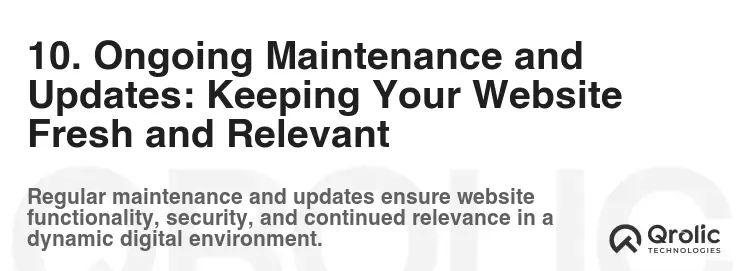
Your website is not a “set it and forget it” project. Ongoing maintenance and updates are essential for keeping your website fresh, secure, and relevant.
10.1. Regular Content Updates: Adding New Content and Keeping Information Current
- Blog Posts: Publish new blog posts regularly.
- Case Studies: Add new case studies.
- Service Updates: Update your service descriptions to reflect changes in immigration law.
- News and Updates: Provide real-time news and updates on changes in immigration laws and policies.
10.2. Security Updates: Protecting Your Website from Cyber Threats
- Software Updates: Keep your website’s software up-to-date with the latest security patches.
- Password Management: Use strong passwords and change them regularly.
- Firewall Protection: Implement firewall protection to prevent unauthorized access to your website.
10.3. Performance Monitoring: Ensuring Optimal Website Speed and Functionality
- Monitor Website Speed: Monitor your website’s speed and performance.
- Fix Broken Links: Fix broken links and other technical issues.
- Test Functionality: Test all website functionality regularly to ensure that it is working properly.
11. Qrolic Technologies: Your Partner in Immigration Website Development
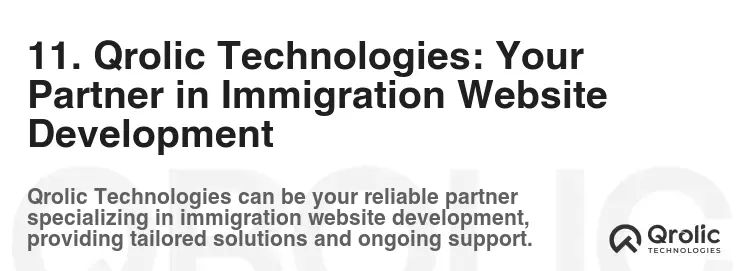
Qrolic Technologies (https://qrolic.com/) is a leading provider of website development and digital marketing services for immigration consultants. We understand the unique needs of the immigration industry and can help you create a website that attracts new clients and grows your business.
11.1. Our Services: Tailored Solutions for Immigration Consultants
- Website Design and Development: We create custom website designs that are visually appealing, user-friendly, and optimized for search engines.
- SEO Services: We help you improve your website’s search engine ranking and attract more organic traffic.
- Content Marketing: We create high-quality content that engages your target audience and establishes you as a trusted authority in the immigration field.
- Social Media Marketing: We help you build a strong social media presence and connect with potential clients.
- PPC Advertising: We create and manage pay-per-click (PPC) advertising campaigns that drive targeted traffic to your website.
11.2. Why Choose Qrolic Technologies?
- Industry Expertise: We have extensive experience working with immigration consultants and understand the unique challenges and opportunities in this industry.
- Custom Solutions: We create custom solutions that are tailored to your specific needs and goals.
- Results-Driven Approach: We are committed to delivering results and helping you grow your business.
- Dedicated Support: We provide dedicated support and are always available to answer your questions.
11.3. Get Started Today: Transforming Your Online Presence
Contact Qrolic Technologies today to learn more about how we can help you create a website that attracts new clients and grows your immigration consulting practice. Let us help you build an “immigration website” that delivers real results, improve your “service packages” presentation, and effectively showcase your “case studies.”
By implementing these top website features, you’ll create a powerful online presence that not only attracts potential clients but also builds trust, establishes your expertise, and ultimately drives the success of your immigration consulting practice. Remember that an investment in your website is an investment in your business’s future.






